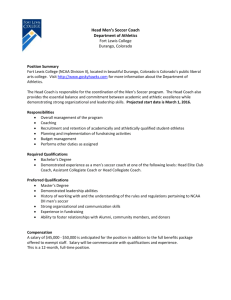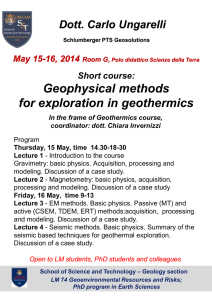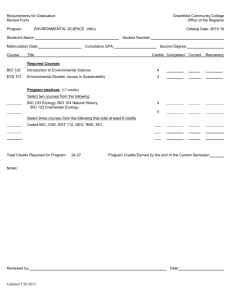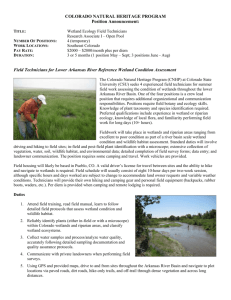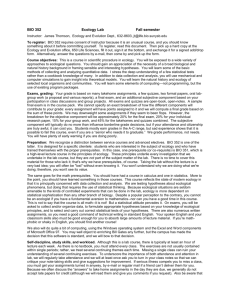C.V. (Resume) - Fort Lewis College
advertisement
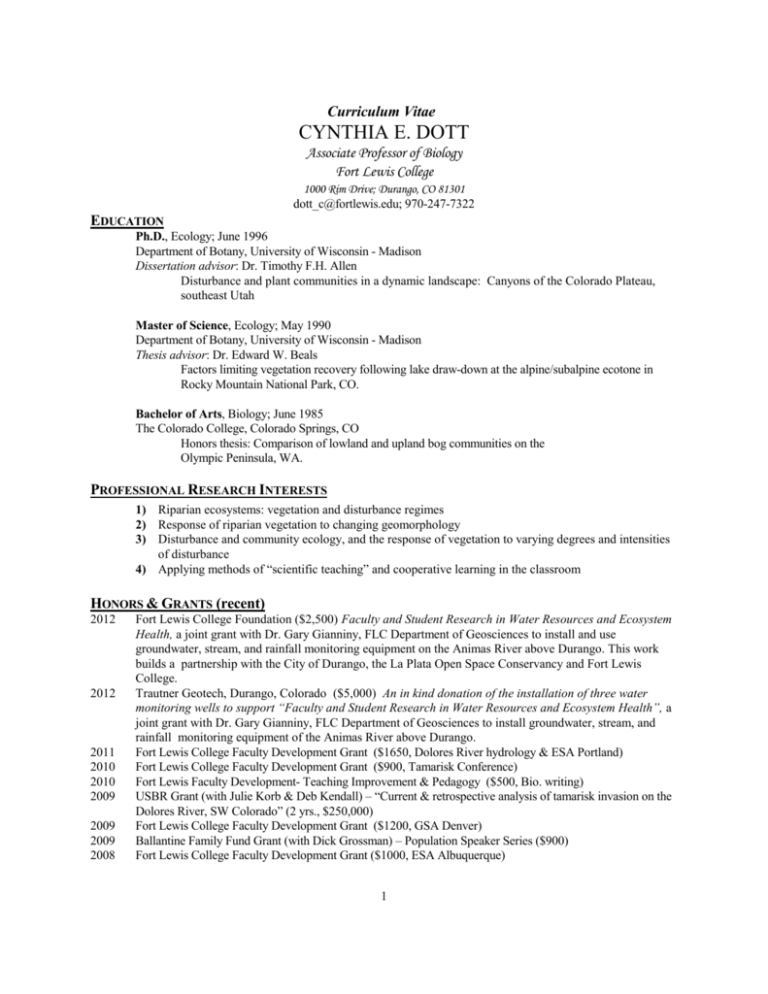
Curriculum Vitae CYNTHIA E. DOTT Associate Professor of Biology Fort Lewis College 1000 Rim Drive; Durango, CO 81301 dott_c@fortlewis.edu; 970-247-7322 EDUCATION Ph.D., Ecology; June 1996 Department of Botany, University of Wisconsin - Madison Dissertation advisor: Dr. Timothy F.H. Allen Disturbance and plant communities in a dynamic landscape: Canyons of the Colorado Plateau, southeast Utah Master of Science, Ecology; May 1990 Department of Botany, University of Wisconsin - Madison Thesis advisor: Dr. Edward W. Beals Factors limiting vegetation recovery following lake draw-down at the alpine/subalpine ecotone in Rocky Mountain National Park, CO. Bachelor of Arts, Biology; June 1985 The Colorado College, Colorado Springs, CO Honors thesis: Comparison of lowland and upland bog communities on the Olympic Peninsula, WA. PROFESSIONAL RESEARCH INTERESTS 1) Riparian ecosystems: vegetation and disturbance regimes 2) Response of riparian vegetation to changing geomorphology 3) Disturbance and community ecology, and the response of vegetation to varying degrees and intensities of disturbance 4) Applying methods of “scientific teaching” and cooperative learning in the classroom HONORS & GRANTS (recent) 2012 2012 2011 2010 2010 2009 2009 2009 2008 Fort Lewis College Foundation ($2,500) Faculty and Student Research in Water Resources and Ecosystem Health, a joint grant with Dr. Gary Gianniny, FLC Department of Geosciences to install and use groundwater, stream, and rainfall monitoring equipment on the Animas River above Durango. This work builds a partnership with the City of Durango, the La Plata Open Space Conservancy and Fort Lewis College. Trautner Geotech, Durango, Colorado ($5,000) An in kind donation of the installation of three water monitoring wells to support “Faculty and Student Research in Water Resources and Ecosystem Health”, a joint grant with Dr. Gary Gianniny, FLC Department of Geosciences to install groundwater, stream, and rainfall monitoring equipment of the Animas River above Durango. Fort Lewis College Faculty Development Grant ($1650, Dolores River hydrology & ESA Portland) Fort Lewis College Faculty Development Grant ($900, Tamarisk Conference) Fort Lewis Faculty Development- Teaching Improvement & Pedagogy ($500, Bio. writing) USBR Grant (with Julie Korb & Deb Kendall) – “Current & retrospective analysis of tamarisk invasion on the Dolores River, SW Colorado” (2 yrs., $250,000) Fort Lewis College Faculty Development Grant ($1200, GSA Denver) Ballantine Family Fund Grant (with Dick Grossman) – Population Speaker Series ($900) Fort Lewis College Faculty Development Grant ($1000, ESA Albuquerque) 1 2007 2007 2006 2004 2004 USBR Grant (with Joseph Ortega) – “Re-evaluation of ALP impacts on cottonwood recruitment and survival, Animas River” ($15,620) Fort Lewis College Faculty Development Grant ($1500, ESA Milwaukee) Fort Lewis College Faculty Development Grant ($1,146, ALE Tucson) Fort Lewis College Faculty Development Grant ($1,275,GIS workshop) Colorado Division of Wildlife Grant - “Grazing exclosures and riparian recovery in Lone Mesa State Park, CO” ($4,764) PROFESSIONAL EXPERIENCE Teaching: Fall 2008-Present Associate Professor Department of Biology, Fort Lewis College, Durango, CO Tenured faculty member in half-time job-share position, participating in Department and College-wide service and research. Courses taught: (2 per semester on average) Bio 112- Introduction to Evolutionary & Organismal Biology (Bio majors & Gen Ed) Bio 125- Conservation Biology (Gen Ed) Bio 141- People & the Planet (Gen Ed) Bio 250- Ecology of the SW (Gen Ed) ENVS 220- Environmental Studies Colloquium Bio 320- Fundamentals of Ecology Bio 376- Field Ecology Bio 496 - Senior Seminar Bio 497- Senior Thesis July 2007 Native Plant Master Course Instructor Colorado State University – Extension, Montezuma County Taught 3, 1 day sessions as part of Native Plant Master program. Course location Lone Mesa State Park near Dolores, UT Fall 2002-Spring 2008 Assistant Professor Department of Biology, Fort Lewis College, Durango, CO Tenure track faculty in half-time job-share position, teaching and participating in Department and College-wide service and research. Courses taught: Bio 112, Bio 110 lab, Bio 125, GS 100, Bio 250, Bio 220/320, Bio 380, Bio 471/376, Bio 496, Bio 497 2001/2002 (academic year) Adjunct Professor Department of Biology, Fort Lewis College, Durango, CO Taught two courses in the fall trimester and 3 in the winter for the Biology department, totaling 9.5 and 10.5 credits, respectively. Fall: Bio 112 - An Introduction to Organismic and Evolutionary Biology for majors - 3 hrs lecture & 2, 1 hr recitations/ wk Bio/SW 250 - Ecology of the Southwest for non-majors - 3 hrs lecture & 3 hrs lab/wk (this was the first time this course was offered, so I developed it from scratch) Winter: Bio/SW 250 – Ecology of the Southwest – non-majors 4 credit course with lab. Bio 380W – Issues in Evolutionary Thought – majors 4 credit course with writing emphasis. Bio 496 – Senior Seminar – majors 2 credit introduction to writing a research proposal. 2 2001 & 2000 (fall) Visiting Instructor Integrated Learning Program (ILP), Fort Lewis College, Durango, CO Taught 1 credit ecology segment in the Integrated Learning Program, under the direction of Cathy Simbeck. I presented an introduction to ecology and ecological systems, including a description of plant (and animal) communities of the Durango region and of the Grand Canyon. Students collected, analyzed, and compared vegetation data from tree and shrub communities in Durango, at the Grand Canyon, and at Mesa Verde. 1999 (fall) Laboratory Instructor Dept. of Biology, Fort Lewis College, Durango, CO Instruction and evaluation of students in non-majors general biology laboratory (Biology 100), including both lab and field exercises. 1999 (spring) Laboratory Instructor Dept. of Biology, Bucknell University, Lewisburg, PA Responsible for instruction and evaluation of students in second semester general biology (zoology) lab. Tasks included supervision of student teaching assistant. 1991-1995 and 1988-1990 Teaching Assistant Dept. of Botany, Univ. of Wisconsin; Madison, WI Taught field and lab sections of the following upper and introductory level ecology courses: Botany 240 - "Plants & Man" (3 times) – Survey of connections between human social history and human uses of plants throughout that history. Bot/Zoology 260 - "Introductory Ecology" (1 time) – A survey of important ecological and environmental issues geared specifically toward the non-science major. Subtitled “Ecology for Voters.” Bot/Forestry 455 - "Vegetation of Wisconsin" (2 times) - Plant community ecology and disturbance ecology, using native vegetation types of Wisconsin as specific examples. Ecological concepts, data collection, data analysis and summary, independent field research project (supervised by the T.A.) and formal research reports were emphasized throughout the course. The audience were upper-level biology majors and incoming graduate students. Bot/Zoo/For 460 - "General Ecology" (2 times) – A standard course providing an overview of ecological concepts for biology majors, including a rigorous lab with both an indoor and outdoor component. Also led lab and discussion sections of two introductory botany courses: Botany 100 - "Survey of Botany" (non-majors) (once in academic year, twice in summer session) Bot 130 - "General Botany" (majors) (1 time) Ecological Research: 2009-11 Riparian Ecologist Current & retrospective analysis of tamarisk invasion on the Dolores River, SW Colorado This large, two-year project was designed to address two questions : 1) What environmental conditions lead to differences in woody vegetation composition – especially the presence of tamarisk – on a regulated river. This portion of the project also yielded detailed descriptions of understory community dynamics in the three dominant vegetation canopy types on the river (cottonwood, willow, tamarisk). 2) What conditions in the past led to successful tamarisk recruitment – using dendrochronology, historical climate and flow data. Dr. Julie Korb (FLC Biology) and I were co-PIs on this project, and supervised a 5 student field crew for much of the data collection. Sara Bombacci (FLC graduate) was our crew leader. Dr. Deb Kendall (Biology) investigated a third question related to tamarisk leaf beetle impacts on the insect community. 3 2007 Consulting Ecologist Re-evaluation of ALP impacts on cottonwood recruitment and survival, Animas River Analysis of existing data and life-history information to determine potential impacts of the Animas-La Plata Project pumping of Animas River water below Durango. The Bureau of Reclamation was gathering information to guide operation of the new pumping project so as to minimize impact on species and habitats of concern. Cottonwood (Populus angustifolia) is an indicator of floodplain health, and determining minimum and maximum river flows to maintain cottonwood health was the primary goal of this review. Dr. Joseph Ortega (FLC Biology) and I co-authored the report. 2006 (May-June) Consulting Ecologist Biological Assessment of Dalla Mountain Park; Durango, CO Open Space Program Conducted survey of newly acquired open space property on the edge of Durango, CO. The purpose of this survey was to document the location of unique biological resources on this property, locate those resources using GPS, and – in conjunction with the City Geographic Information Systems office – generate a GIS map of the property showing the location of important resources. The City used this information to guide trail work and fire mitigation thinning work on the property. One student hourly worker also employed in this project. 2003-2006 (summers) Riparian Ecologist Long-Term Monitoring of Grazing Impacts; Lone Mesa State Park, CO Established permanent vegetation sampling plots in riparian corridor of newly-acquired State Park Lands north of Dolores, Colorado. Long-term monitoring of grazing impacts in and outside of fenced cattle exclosures was begun in summer 2003 and will continue into the foreseeable future. Initial sampling work funded by Colorado Division of Wildlife. 2001 Field Ecologist (summer) Westside Pines Project; San Juan National Forest; Dolores, CO Worked with Julie Korb to re-survey Ponderosa pine restoration plots established by Bill Romme and Lisa Floyd-Hanna in conjunction with the National Forest Service. Included re-locating established sites in control and treatment plots, measuring cover of understory vegetation, and compiling detailed lists of herbaceous species. Data will be used to assess understory recovery after thinning and burning, in an attempt to restore ponderosa pine ecosystems to a more sustainable state. 1991 Peregrine Falcon Survey Supervisor (spring/summer) Canyonlands National Park; Moab, UT Led inventory of National Park lands for new peregrine nesting sites; monitored known sites in the Park. Duties included supervision of one assistant. 1991 Botanical Consultant / Subcontractor (summer) Abajo Archaeology; Bluff, UT Conducted surveys for rare, threatened and endangered plant species along proposed powerline corridors in southeast Utah. 1989 and 1990 Assistant Plant Ecologist (summers) Rocky Mountain National Park; Estes Park, CO Investigated the dynamics of vegetation recovery on human and naturally disturbed sites, over a variety of habitats and elevation zones. 4 PUBLICATIONS & PRESENTATIONS Clutter, Melissa J., Gianniny, Gary.L., Dott, C. 2011. Dam release and monsoon controlled recharge and drawdown of riparian aquifers, Dolores River, Colorado.Metamorphosis: COPLAC journal of undergraduate research, 2(2), http://www.coplac.org/metamorphosis. Dott, Cynthia, Melissa Boley & Gary Gianniny. 2011. Interaction of groundwater and riparian vegetation on a dam-controlled stream: Dolores River, southwest Colorado. 11th Biennial Conference of Research on the Colorado Plateau. Bombaci, Sara, Julie Korb & Cynthia Dott. 2011. Dendrochronology analysis of environmental factors favoring tamarisk recruitment along the Dolores River below McPhee Dam, southwest Colorado. 11th Biennial Conference of Research on the Colorado Plateau. Boley, Melissa, Gary Gianniny & Cynthia Dott. 2011. Dam release and monsoon controlled recharge and drawdown of riparian aquifers, Dolores River, Colorado. 63rd Annual Meeting of the Rocky Mountain Section of the Geological Society of America, Program & Abstracts. Dott, Cynthia E., Julie Korb & Sara Bombaci. 2011. Landscape distribution of woody riparian vegetation on floodplains of the regulated Dolores River, SW Colorado. 2011Tamarisk Research Conference, Program & Abstracts. Korb, Julie E., Cynthia E. Dott, & Sara P. Bombaci. 2011. Understory plant community variability among tamarisk, cottonwood, and willow canopy types along a regulated reach of the Dolores River, Colorado – Implications for ecological restoration. 2011 Tamarisk Research Conference, Program & Abstracts. Dott, Cynthia E. & Koehler, Richard. 2010. Impacts of earlier snowmelt on patterns of streamflow in southwest Colorado rivers. Geological Soc. of Amer. 2010 Annual Meeting, Program & Abstracts. Dott, Cynthia E. 2009. The Severed Link: Geomorphology & Riparian Habitat Decline on a Dammed Western River. Ecol. Soc. Amer. 94th Annual Meeting, Program & Abstracts. Dott, Cynthia. January 2009, posting date. Of wolves, elk and willows: how predation structures ecosystems. Teaching Issues and Experiments in Ecology, Vol. 6: Issues Figure Set #2 [online]. http://tiee.ecoed.net/vol/v6/figure_sets/trophic_cascades/abstract.html Dott, Cynthia E. and Joseph C. Ortega. Oct. 2008. A Re-evaluation of the Effects of the Current Animas-La Plata Project on Seedling Establishment and Long-term Survival of Populus angustifolia on the Animas River. US Bureau of Reclamation Report. Dott, Cynthia E. 2008. All Hands in the Field: Combining Undergraduate Education with Long-Term Ecological Monitoring & Data Collection. Ecol. Soc. Amer. 93rd Annual Meeting, Program & Abstracts Watkins, S., C.E. Dott and B. Wolcott 2007. Grazing impacts on native willow species abundance. 9th Biennial Conference of Research on the Colorado Plateau, Program & Abstracts, October 2007. 5 Wolcott, B., C.E. Dott and S. Watkins 2007. Does grazing regime influence weed abundance? 9th Biennial Conference of Research on the Colorado Plateau, Program & Abstracts, October 2007. Dott, Cynthia E. 2007. Disturbance as feedback: Disturbances at multiple scales in riparian systems on the Colorado Plateau. US-Internatl Assoc Landscape Ecology, Program & Abstracts, April 2007. Dott, Cynthia E. 2006. Biological survey of the Dalla Mountain Park Open Space property, City of Durango, CO. Unpublished report for the City of Durango Open Space Program, directed by Kevin Hall. Dott, Cynthia E. 2004. Can degraded riparian vegetation recover under a light grazing regime? Evidence from SW Colorado. Ecological Society of America, Program & Abstracts, August 2004. Dott, Cynthia E. & T.F.H. Allen 1994. Establishing spatiotemporal spheres of influence for disturbance factors in riparian systems of the Colorado Plateau. U.S. Landscape Ecology 9th Annual Symposium, Program & Abstracts. Dott, Cynthia E. & T.F.H. Allen 1993. Developing an approach to address the problem of "historical accidents": an example from SE Utah canyons. Ecological Soc. of America Bulletin, Program & Abstracts 74(2, Suppl.):218. Dott, Cynthia E. 1992. Roles of landscape history, human land-use history, and vegetation history in shaping plant communities in canyons of the Colorado Plateau. Natural Areas Assoc. 19th Annual Conference, Abstracts. Dott, Cynthia & Bill Sloan. 1991. Distribution and reproductive success of peregrine falcons (Falco peregrinus anatum) in Canyonlands and Arches National Parks, 1991. Report to the National Park Service, Canyonlands National Park, Utah. Dott, Cynthia E. 1991. Biological assessment and endangered and threatened plant species surveys along proposed distribution lines on Navajo Nation Lands, San Juan County, Utah. Three Reports to Utah Power and Light Company, in conjunction with Abajo Archaeology. 6 REFERENCES Dr. Timothy F.H. Allen - Department of Botany, University of Wisconsin, Madison; Professor (608) 262-2692, tfallen@facstaff.wisc.edu Dr. Jayne Belnap - U.S. Geological Survey, National Biological Division; Scientist, Canyonlands National Park, UT (435) 719-2333, jayne_belnap@usgs.gov PROFESSIONAL AFFILIATIONS Ecological Society of America EcoEd Digital Library – Education Section AAAS AIBS The Nature Conservancy Phi Beta Kappa OTHER INTERESTS Bird-watching, hiking, nordic skiing, camping, bicycling, rafting, canoeing… Parenting, gardening Sustainable agriculture Old time music (mandolin & fiddle) and contra / square dancing 7
